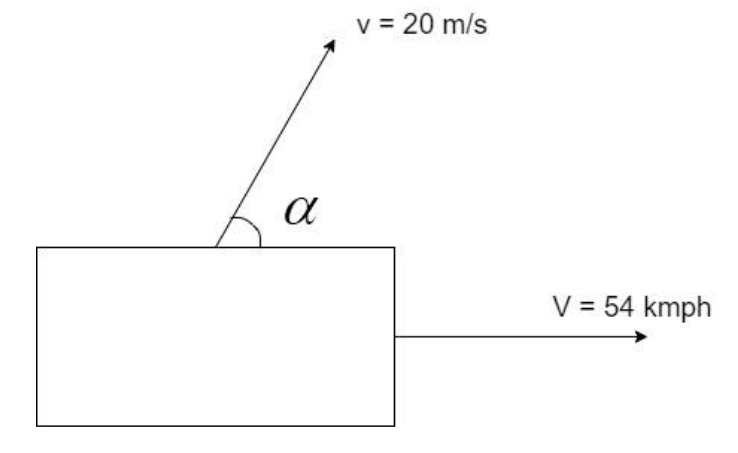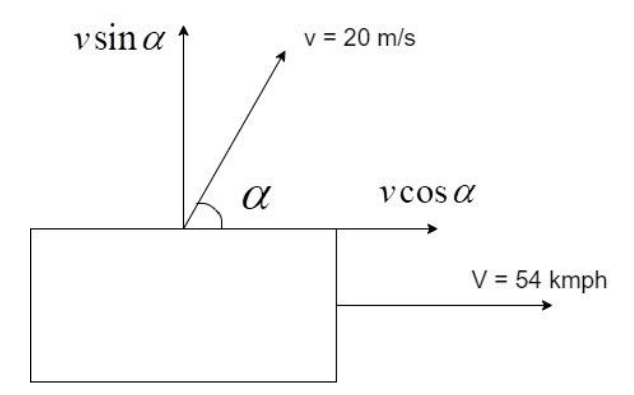
A truck is moving with a constant velocity of 54 kmph. In what direction should a stone be projected up with a velocity of 20 m/s, from the floor of the truck, so as to appear at right angles to the truck, for a person standing on earth?


Answer
545.1k+ views
Hint: By the definitions of scalar and vector quantities, All physical quantities can be classified into scalar and vector, wherein scalar quantities have only magnitude while vector quantities have direction too. Vectors cannot be operated with basic scalar operators.
Complete step by step answer:
The rate of change of distance per unit time is called speed. However, speed only represents the magnitude of the change of the distance with time but does not give an indication of the direction. Hence, it is a scalar quantity. So, we have another quantity velocity, which takes into consideration the direction in which the distance changes with respect to time, along with the magnitude.
Consider the following setup with a truck moving at a constant velocity, V = 54 km/hr.
A stone is thrown off the truck with a velocity, v = 20 m/s with an angle of $\alpha $.
The velocity of the stone, v is considered a vector. It can be considered as a vector sum of its horizontal and vertical components, $v\cos \alpha $ and $v\sin \alpha $ as shown below:

Here, we see that the component $v\sin \alpha $ is pointed in the upward direction and the other component $v\cos \alpha $ is pointed in the other direction.
For an observer on the ground, the relative velocity of the stone with respect to the truck, is given by:
${V_R} = V + v\cos \alpha $
Now, if the observer sees zero velocity in the horizontal direction, it means that the relative velocity, as stated above, is equal to zero.
$\therefore {V_R} = 0$
Substituting the values of the velocities, we get –
$V + v\cos \alpha = 0$
$ \Rightarrow 54 \times \dfrac{5}{{18}} + 20\cos \alpha = 0$
$ \Rightarrow 15 + 20\cos \alpha = 0$
$ \Rightarrow \cos \alpha = - \dfrac{{15}}{{20}}$
$ \Rightarrow \alpha = {\cos ^{ - 1}}\left( { - \dfrac{{15}}{{20}}} \right) = {\cos ^{ - 1}}\left( { - 0 \cdot 75} \right) = 138 \cdot {59^ \circ }$
Hence, the stone is projected at an angle of $138 \cdot {59^ \circ }$.
Note: The rate of conversion from one unit of velocity kilometre per hour to another unit metre-per-second is given as follows:
$1kmph = \dfrac{{1km}}{{1hr}} = \dfrac{{1000m}}{{3600\sec }} = \dfrac{5}{{18}}m{s^{ - 1}}$
Hence, 1 kmph is equal to $\dfrac{5}{18}^{th}$ of 1m/s.
Complete step by step answer:
The rate of change of distance per unit time is called speed. However, speed only represents the magnitude of the change of the distance with time but does not give an indication of the direction. Hence, it is a scalar quantity. So, we have another quantity velocity, which takes into consideration the direction in which the distance changes with respect to time, along with the magnitude.
Consider the following setup with a truck moving at a constant velocity, V = 54 km/hr.
A stone is thrown off the truck with a velocity, v = 20 m/s with an angle of $\alpha $.
The velocity of the stone, v is considered a vector. It can be considered as a vector sum of its horizontal and vertical components, $v\cos \alpha $ and $v\sin \alpha $ as shown below:

Here, we see that the component $v\sin \alpha $ is pointed in the upward direction and the other component $v\cos \alpha $ is pointed in the other direction.
For an observer on the ground, the relative velocity of the stone with respect to the truck, is given by:
${V_R} = V + v\cos \alpha $
Now, if the observer sees zero velocity in the horizontal direction, it means that the relative velocity, as stated above, is equal to zero.
$\therefore {V_R} = 0$
Substituting the values of the velocities, we get –
$V + v\cos \alpha = 0$
$ \Rightarrow 54 \times \dfrac{5}{{18}} + 20\cos \alpha = 0$
$ \Rightarrow 15 + 20\cos \alpha = 0$
$ \Rightarrow \cos \alpha = - \dfrac{{15}}{{20}}$
$ \Rightarrow \alpha = {\cos ^{ - 1}}\left( { - \dfrac{{15}}{{20}}} \right) = {\cos ^{ - 1}}\left( { - 0 \cdot 75} \right) = 138 \cdot {59^ \circ }$
Hence, the stone is projected at an angle of $138 \cdot {59^ \circ }$.
Note: The rate of conversion from one unit of velocity kilometre per hour to another unit metre-per-second is given as follows:
$1kmph = \dfrac{{1km}}{{1hr}} = \dfrac{{1000m}}{{3600\sec }} = \dfrac{5}{{18}}m{s^{ - 1}}$
Hence, 1 kmph is equal to $\dfrac{5}{18}^{th}$ of 1m/s.
Recently Updated Pages
The number of solutions in x in 02pi for which sqrt class 12 maths CBSE

Write any two methods of preparation of phenol Give class 12 chemistry CBSE

Differentiate between action potential and resting class 12 biology CBSE

Two plane mirrors arranged at right angles to each class 12 physics CBSE

Which of the following molecules is are chiral A I class 12 chemistry CBSE

Name different types of neurons and give one function class 12 biology CBSE

Trending doubts
One Metric ton is equal to kg A 10000 B 1000 C 100 class 11 physics CBSE

State the laws of reflection of light

Explain zero factorial class 11 maths CBSE

What is 1s 2s 2p 3s 3p class 11 chemistry CBSE

An example of chemosynthetic bacteria is A E coli B class 11 biology CBSE

10 examples of friction in our daily life




